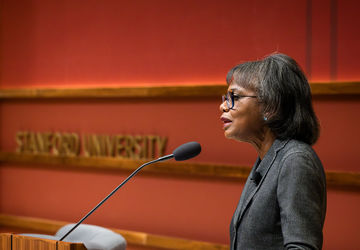Disparities in cultural alignment challenge women's career ambitions in tech
A recent forum organized by the Center for the Advanced Study of the Behavioral Sciences took an innovative view of barriers to women’s advancement in tech. Two professors with long-standing research projects in the field, Shelley Correll and Sapna Cheryan, explored the role that stereotypes play in dampening women’s participation, persistence, and advancement in tech.
Correll, Director of the Clayman Institute and Professor of Sociology at Stanford University, presented findings that showed the effect of bias on women’s opportunities for advancement in tech. Through an analysis of a randomly selected set of anonymized employee performance evaluations from a large tech firm, Correll quantified how the language used in managerial evaluations reinforced stereotypical gender norms and resulted in the undervaluation of women employees. Women’s accomplishments are less likely to be described using the kind of language that most matters to be positioned in the industry: strategic, visionary, and “game-changing.” Furthermore, women are penalized, Correll explained, for having communication styles that are “too aggressive,” while, inversely, men are penalized for communication styles that are “too soft.” These penalties reflect the likeability-competence tradeoff, wherein women who are seen as competent are viewed as unlikeable, but where women who are seen as likeable can be viewed as not competent. By contrast, men who do not confirm to the stereotypical “assertive male leader” model are similarly penalized. In other words, stereotypes can police behavior into a narrow definition of leadership that perpetuate the gender disparity at the leadership level, and also penalizes men who do not fit in that narrow definition.
Dissatisfaction, Correll observed, with the pay and promotion process are among the chief reasons why women leave jobs in the tech industry at a higher rate than men. This indicates that interventions in the employee assessment process are important to reduce the tech industry gender disparity. Early results from Correll’s current research on employee evaluation methods show that relatively simple measures—for example, the introduction of checklists with unambiguous evaluation criteria—can meaningfully reduce the effects of gender bias on promotion procedures. “Ambiguity opens the door to bias,” Correll contended. There’s no reason to think these managers are deliberately undervaluing women’s accomplishments; they are instead having to make quick decisions in ambiguous situations. For example, managers are often asked to evaluate one’s “leadership potential” with no clear definition. In such cases, stereotypes about leadership may influence their decision making. By eliminating ambiguity in performance criteria, companies can both reduce gender bias and improve management confidence in the consistency and usefulness of the evaluations they perform. This last aspect of Correll’s findings is particularly exciting, since even managers who are less committed to gender diversity are incentivized to become positive change agents, once they see that simple changes can enable them to evaluate all people more easily, fairly, and consistently.
Correll’s research addressed the factors playing into the gender disparity of performance assessment once they are in the technology workplace— but how may we explain why 40% of qualified women choose not to enter the field altogether? This is the conundrum addressed by Sapna Cheryan in her research on how heavily coded masculine workplace environments deter women from taking jobs in tech. Her research was in part inspired by her own experience of choosing between two summer job offers at Silicon Valley firms. Cheryan, Associate Professor of Social Psychology at the University of Washington and former Clayman Institute Graduate Dissertation Fellow, explained that she chose one offer over the other, not because of the salary offered or the type of work available, but because the company’s office environment seemed more welcoming to her. Her research showed that her reaction was not uncommon—the exclusive presence of objects that send stereotypical geek-culture signals (such as sci-fi posters adorning the walls to empty beer cans cluttering tables) discourage women from imagining themselves in tech industry jobs, and also discourage girls from imagining themselves as computer science majors.
Without space to imagine themselves in the field, more women will not enter tech. Cheryan labeled the fit that people feel with the material components of an environment “ambient belonging.” That is, a sense of belonging in a specific workplace or profession can be signaled and experienced through signals experienced in the environment (such as office space). While she did not advocate the total removal of geek-culture signifiers, she did recommend cultivating workplace environments that provide a sense of ambient belonging to a broader range of people. Adopting a less stereotypical set of cultural signifiers can help women imagine themselves in tech jobs. Women’s ability to imagine themselves in tech—in the literal spaces and environments—is integral to them both accepting job offers and pursuing long-term careers in tech. Once in the workplace, it is likely that these cultural signals keep affecting women’s sense of belonging.
Gender disparity in the tech industry is a pressing problem, but not necessarily an intractable one. Both research presentations showed how relatively small changes in industry practices—changes that many companies are eager to make—can result in meaningfully improved gender equity.


